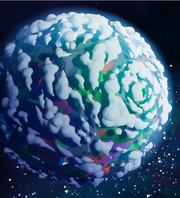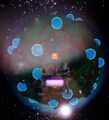(Introduction) Tag: Visual edit |
Sdkphoenix (talk | contribs) No edit summary |
||
| Line 1: | Line 1: | ||
[[File:Sylva.png|thumb|The starting planet [[Sylva]].]] |
[[File:Sylva.png|thumb|The starting planet [[Sylva]].]] |
||
| + | Planets are astronomical bodies in [[Astroneer]] that the play may travel to, explore and construct bases on. Moons exist as well, but they share the same characteristics as planets, and are treated as such. |
||
| − | In ''[[Astroneer]]'', a '''planet''' is an astronomical body the player can visit. Different than in real-life astronomy, in the game, celestial bodies that orbit other planets are not called ''moons'', but also ''planets''. |
||
| − | + | There are currently five planets, with two moons. These are, starting from the one closest to the Sun, {{PlanetLink|Atrox}}, {{PlanetLink|Calidor}}, {{PlanetLink|Sylva}}, {{PlanetLink|Vesania}}, and {{PlanetLink|Glacio}}. The moons, {{PlanetLink|Desolo}} and {{PlanetLink|Novus}}, orbit [[Sylva]] and [[Vesania]], respectively. |
|
| + | Planets are procedurally generated upon creation of a new save, each having unique characteristics, with different types of [[Flora]], [[Biome]]s, and [[Resources]]. Planets share the same universal [[resources]], while all but [[Atrox]] have a Primary and a Secondary resource, which each exists on only two planets. Atrox is unique in having four atmospheric resources, with one being unique to the planet, while [[Desolo]], having no atmosphere, has no [[atmospheric]] resources. [[Research Items]] and [[Research Sample|Samples]] are also different per planet, with different colors, amounts of bytes, and research times. |
||
| − | Planets in-game are procedurally generated, broadly spherical worlds, each with a unique look. Each planet offers a unique set of naturally occuring [[resources]], [[flora]], and [[collectibles]]. They also differ among multiple dimensions, in particular, size, gravity, length of solar days, effectiveness of power generation using [[Solar Panels|solar]] or [[Wind Turbines|wind]] energy and the number of [[Gateway Chamber|Gateway Chambers]]. |
||
| + | Planets also have unique size, gravity, length of the day/night cycle, and power generation, with some planets being better for [[Solar Panels|solar]] power, and others for [[Wind Turbines|wind]] power. |
||
| − | The surface of each planet is divided into distinct [[Biome|biomes]], which again differ in several ways. Internally, most planets are structured as rigid bodies with three distinct layers: An inner core, an outer core, a mantle, and a crust, each again with differing sets of resources and native flora. Surprisingly, extensive cave systems penetrate most of the planets interior, sometimes stretching from the surface down to the outer core. |
||
| + | Each planet have the same basic layout of five main layers: the surface, caves, mantle, outer core and inner core. Due to the generation of terrain, some caves can stretch from the surface to the outer core on certain planets, as well as some layers blending together without much distinction, such as on [[Desolo]]. |
||
| − | Also, all planets except [[Desolo]] feature an atmosphere from which the player can extract various [[Resources#Atmospheric Resources|atmospheric resources]]. All of these features combined also affect the difficulty of operating on each of the planets. |
||
| ⚫ | |||
| − | The list below lists all planets in the game as well as, inter alia, which unique set of resources is available. |
||
| − | |||
| ⚫ | |||
{| class="zebra darktable" |
{| class="zebra darktable" |
||
!Planet |
!Planet |
||
| Line 81: | Line 79: | ||
|- |
|- |
||
| {{PlanetLink|Glacio}} |
| {{PlanetLink|Glacio}} |
||
| − | | Tundra |
+ | | Tundra |
| {{ItemLink|Titanite}} |
| {{ItemLink|Titanite}} |
||
| {{ItemLink|Hematite}} |
| {{ItemLink|Hematite}} |
||
| Line 153: | Line 151: | ||
==Trivia== |
==Trivia== |
||
| − | *Some of the planets are loosely based on the [https://en.wikipedia.org/wiki/Solar_System Solar System]. Sylva and Desolo are both based on Earth and the Moon, Atrox is based on the toxicity of Venus, Calidor on Mars, and Glacio could be based on either Uranus or Neptune, as both have icy cores. Vesania and Novus could be based on Jupiter or Saturn's moons. |
+ | * Some of the planets are loosely based on the [https://en.wikipedia.org/wiki/Solar_System Solar System]. Sylva and Desolo are both based on Earth and the Moon, Atrox is based on the toxicity of Venus, Calidor on Mars, and Glacio could be based on either Uranus or Neptune, as both have icy cores. Vesania and Novus could be based on Jupiter or Saturn's moons. |
==Media== |
==Media== |
||
Revision as of 05:43, 2 January 2021

The starting planet Sylva.
Planets are astronomical bodies in Astroneer that the play may travel to, explore and construct bases on. Moons exist as well, but they share the same characteristics as planets, and are treated as such.
There are currently five planets, with two moons. These are, starting from the one closest to the Sun, ![]() Atrox,
Atrox, ![]() Calidor,
Calidor, ![]() Sylva,
Sylva, ![]() Vesania, and
Vesania, and ![]() Glacio. The moons,
Glacio. The moons, ![]() Desolo and
Desolo and ![]() Novus, orbit Sylva and Vesania, respectively.
Novus, orbit Sylva and Vesania, respectively.
Planets are procedurally generated upon creation of a new save, each having unique characteristics, with different types of Flora, Biomes, and Resources. Planets share the same universal resources, while all but Atrox have a Primary and a Secondary resource, which each exists on only two planets. Atrox is unique in having four atmospheric resources, with one being unique to the planet, while Desolo, having no atmosphere, has no atmospheric resources. Research Items and Samples are also different per planet, with different colors, amounts of bytes, and research times.
Planets also have unique size, gravity, length of the day/night cycle, and power generation, with some planets being better for solar power, and others for wind power.
Each planet have the same basic layout of five main layers: the surface, caves, mantle, outer core and inner core. Due to the generation of terrain, some caves can stretch from the surface to the outer core on certain planets, as well as some layers blending together without much distinction, such as on Desolo.
Planets
| Planet | Type | Primary | Secondary | Gases | Difficulty | Sun | Wind | Gateway Symbol | Gateway Engine Material |
|---|---|---|---|---|---|---|---|---|---|
| Terran | Easy | Medium | Medium | ||||||
| Terran Moon | None | Easy | High | Low | |||||
| Arid | Medium | Very High | Low | ||||||
| Exotic | Medium | Low | High | ||||||
| Exotic Moon | Medium | High | High | ||||||
| Tundra | Hard | Very Low | Very High | ||||||
| Radiated | None | None | Very Hard | Low | Low |
- Primary resources are found between the first underground layer and the mantle of the planet. Secondary resources are found in mountainous biomes on the surface and the layers under the mantle to the core.
Planet Types
The Planets in Astroneer each have a type associated with them. Each type has varying differences, from the amount of sun to the types of resources that it may contain.
| Type | Description | Planet |
|---|---|---|
| Typical lush, Earth-like planet, with plains, mountains, forested hills and gray-blue canyons. | ||
| Marked with craters, big and small. The occasional slightly raised mountains spaced between the gray landscape. | ||
| Dry and dusty dunes, plantlife typical of a desert. Mesas and flat plains mixed in with the dunes. | ||
| Densely forested hills, heavy abundance of plantlife. | ||
| Sparsely forested, with canyons and craters marking the surface. | ||
| Cold and icy, with small hot spots of life, surrounded with tall glaciers, with steep drops to the icy plains below. | ||
| Toxic wastelands, with deep yellow canyons and tall, swiss cheese-like mountains. Abundance of hazardous plantlife and lacking any primary or secondary resources. |
Landing Zones
Landing Zones are locations on each planet that a player may land on using a Shuttle. Landing zones are marked with a sphere when viewed in orbit around the planet, allowing the player to select the zone to land in that location.
Landing Zones appear naturally at the start of the game, or from the use of a Landing Pad. If a Landing Pad is used in or near another landing zone, they may overlap and the player may have trouble selecting the proper zone to land in. Landing Pads do not have Beacons, so they may be hard to distinguish from naturally occurring Landing Zones. In multiplayer, a passenger is also able to select a landing zone to land on, not only the person in the main seat.
Notes
- Each planet has a maximum height that players can build or fly up to using the Hydrazine Jet Pack. This limit extends to the top of the cloud layer of each planet.
Trivia
- Some of the planets are loosely based on the Solar System. Sylva and Desolo are both based on Earth and the Moon, Atrox is based on the toxicity of Venus, Calidor on Mars, and Glacio could be based on either Uranus or Neptune, as both have icy cores. Vesania and Novus could be based on Jupiter or Saturn's moons.
Media
Landing zones on Terran (Pre 1.0)
| |||||
| |||||||||||||||||



